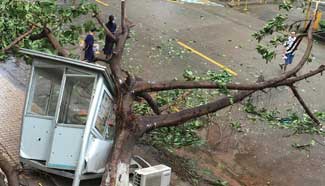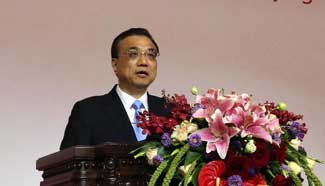The graphics shows China will launch the Tiangong-2 space lab from the Jiuquan Satellite Launch Center in northwestern China's Gobi Desert at 10:04 p.m. on Sept. 15. (Xinhua/Qu Zhendong)
JIUQUAN, Sept. 14 (Xinhua) -- China will launch its Tiangong-2 space lab from the Jiuquan Satellite Launch Center in northwestern China's Gobi desert at 10:04 p.m. Thursday as part of an increasingly ambitious space program that aims for a manned space station by around 2022.
Engineers have begun injecting propellant into the Long March-2F T2 rocket, which will carry Tiangong-2 into space, said Wu Ping, deputy director of the manned space engineering office, on Wednesday afternoon.
"All systems are ready for lift-off," she said.
"The launch of Tiangong-2 will lay a solid foundation for the building and operation of a permanent space station in the future," she said.
She said China's manned space program has now entered a "new phase of application and development."
Once in space, the 8.6-tonne Tiangong-2 will maneuver itself into an orbit about 380 kilometers above Earth for initial on-orbit tests.
It will transfer to a slightly higher orbit about 393 kilometers above Earth, a height at which the future Chinese space station will operate, before the Shenzhou-11 manned spaceship ferries two male astronauts into space to dock with the lab in mid-to-late October.
The two astronauts will work in Tiangong-2 for 30 days before reentering Earth's atmosphere.
In April 2017, China's first cargo ship, Tianzhou-1, will also be sent into orbit to dock with Tiangong-2 and provide it with fuel and other supplies.
Wu said experts will verify and evaluate key technologies involved in on-orbit propellant resupply and equipment repairs as well as that related to long-term stays in space by astronauts.
They will also use the lab, which is designed to operate for at least two years, to conduct space science experiments on a relatively large scale compared to China's previous efforts.
Measuring 10.4 meters in length and 3.35 meters in maximum diameter, Tiangong-2 is much like its predecessor Tiangong-1, which was launched in 2011, but its living quarters and life support facilities have been improved to allow for longer stays by astronauts.
Originally built as a backup for Tiangong-1, it can enable two astronauts to live in space for up to 30 days and is capable of receiving manned and cargo spaceships.
Once inside Tiangong-2, the two astronauts will carry out key experiments related to aerospace medicine, space physics and biology as well as on-orbit equipment repairs in areas such as quantum key transmission, space atomic clock and solar storm research.
More than 40 space science and application experiments will be conducted aboard Tiangong-2.
"The number of experiments carried by Tiangong-2 is the highest so far of all manned space missions," Wu said.
Its payload includes POLAR, a collaboration between Swiss, Polish and Chinese institutions to study gamma ray bursts.
The space cold atomic clock, which scientists say only loses one second about every 30 million years, is expected to make future mobile navigation more accurate.
Also piggybacking on the Tiangong-2 launch will be a micro satellite that will orbit close to the space lab.
Wu said China will share the fruits of its development in its manned space program with all countries, especially developing countries.
Earlier reports said Tiangong-2 will also carry three experiments designed by the winners of a Hong Kong middle school design contest.
According to Wu, Tiangong-2 is China's first space lab "in the strict sense."
Its predecessor, Tiangong-1, which docked with Shenzhou-8, Shenzhou-9 and Shenzhou-10 spacecraft and undertook a series of experiments, was mainly tasked with verifying technology involved in space docking and serving as a platform for a limited number of scientific experiments, Wu said.
Tiangong-1 ended its data service earlier this year.
According to Wu, Tiangong-1 is running at an orbit about 370 kilometers above Earth and descending 100 meters every day. It is expected to burn up in Earth's atmosphere in the latter half of 2017.
![[GRAPHICS]CHINA-SCIENCE-TIANGONG-2 (CN)](135688000_14738985430161n.jpg)











